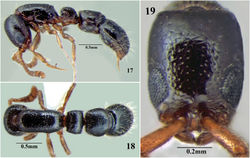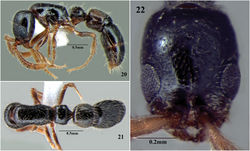Cerapachys nayana
| Notice: | This page is derived from the original publication listed below, whose author(s) should always be credited. Further contributors may edit and improve the content of this page and, consequently, need to be credited as well (see page history). Any assessment of factual correctness requires a careful review of the original article as well as of subsequent contributions.
If you are uncertain whether your planned contribution is correct or not, we suggest that you use the associated discussion page instead of editing the page directly. This page should be cited as follows (rationale):
Citation formats to copy and paste
BibTeX: @article{Bharti2013ZooKeys336, RIS/ Endnote: TY - JOUR Wikipedia/ Citizendium: <ref name="Bharti2013ZooKeys336">{{Citation See also the citation download page at the journal. |
Ordo: Hymenoptera
Familia: Formicidae
Genus: Cerapachys
Name
Cerapachys nayana Bharti & Akbar, 2013 sp. n. – Wikispecies link – ZooBank link – Pensoft Profile
Type material
Holotype worker: India: Kerala, Silent valley national park, 11°5'N, 76°26'E, 897m a.s.l., 25.ix.2011, hand picking. Paratypes: 2 workers and 1 ergatoid queen with same data as holotype; 6 workers and 2 ergatoid queens, India, Karnataka, Gundlupet 11°8'N, 76°68'E, 800m a.s.l., 27.ix.2010, hand picking; 2 workers and 1 ergatoid queen, India, Kerala, Periyar tiger reserve, 9°46'N, 77°14'E, 1005m a.s.l., 10.x.2011, hand picking (coll. Shahid A. Akbar). Holotype in PUAC and paratype in BMNH.
Worker description
Measurements (holotype in brackets): HL 0.55-0.66 (0.66); HW 0.48-0.51 (0.51); EL 0.24-0.27 (0.25); WL 0.60-0.66 (0.66); MH 0.34-0.37 (0.34); PrW 0.33-0.38 (0.34); PL1 0.20-0.23 (0.23); PW1 0.25-0.29 (0.29); IIIAL 0.30-0.44 (0.44); IIIAW 0.37-0.47 (0.37); SL 0.21-0.27 (0.27); IVAL 0.58-0.61 (0.61); IVAW 0.47-0.52 (0.52). Indices: CI 77-87 (77); SI 44-53 (53); PI 125-126 (126) (n=10).
Head. Rectangular, longer than broad, widest at about its midlength; sides parallel, vertexal margin transverse to shallowly concave, posterior lateral corners weakly acute. Parafrontal ridges present but not raised, very low. Eyes large prominent. Mandibles subtriangular; masticatory margin without a row of small denticles. Lateroclypeal teeth small and reduced. Antennae 12 segmented; scapes short, reaching up to 4/5th of posterior margin of head.
Mesosoma. Moderately stout, rectangular in dorsal view; dorsal surface flattened, bordered laterally by a distinct angle, but no margin. Declivous face of propodeum with cariniform margins across the top and along the lateral margins.
Metasoma. Petiole broader than long, with strong overhanging dorsolateral margins. Anterior face concave while posterior face is transverse. Subpetiolar process small with stout acute apex, directed forward, located beneath anterior 1/3rd of the petiole; no fenestra present. Postpetiole sub trapezoidal, wider behind with the posterolateral angles uniformly rounded. Gaster elongate; base of cinctus of first gastral tergite with cross ribs; sting exerted.
Sculpture. Mandibles smooth and shining. Head with small punctures, spaced wider than their diameter, dorsum of head also with faint rugae in between the punctures. Similar sculpture on dorsal surface of mesosoma and petiole. Small continuous punctures produce a matt like appearance on the dorsum of the postpetiole. Gaster with similar matt-like appearance but less prominent. Cinctus of 1st gastral segment smooth and shining.
Vestiture. Body covered with moderate decumbent or subdecumbent hairs most prominent on postpetiole and gaster, head devoid of such hairs, only a few along sides; apical funicular segments with standing hairs.
Colour. Black with mandibles, antennae and legs castaneous.
Ergatoid queen measurements
HL 0.66-0.77; HW 0.55-0.60; EL 0.22-0.24; WL 0.79-0.82; MH 0.36-0.41; PrW 0.44-0.47; PL1 0.24-0.27; PW1 0.44-0.47; IIIAL 0.44-0.47; IIIAW 0.51-0.55; SL 0.18-0.22; IVAL 0.58-0.63; IVAW; 0.60-0.66. Indices: CI 77-83; SI 33-37; PI 174-183 (n=3).
Like the workers of the same colony, but larger, with thicker body, especially mesosoma and gaster. Ocelli present on vertex, prominent. The pilosity is much more prominent compared to workers. Distinction between ergatoid queens and worker is vague, with size variation of workers very high.
Variations
There is a considerable amount of size variation between individual specimens, the smaller workers are lighter in body colouration compared with larger specimens; the body sculpture and pilosity also differs between individuals.
Etymology
The species epithet is Sanskrit for “eyes”, in reference to the large eye size of the species.
Differential diagnosis
With themarginate dorsolateral sides of its petiole, this species is easily distinguished from other Indian species of its genus. The new species sharesmost characters with Cerapachys anokha from which it is separated by the combination of characters given in the diagnosis of the latter species. Cerapachys nayana is compared with Cerapachys longitarsus which also has marginate dorsolateral sides to the petiole; however, the two species can be easily separated. Cerapachys longitarsus has characteristic bicolouration, with the head brown, trunk red or brown, petiole and postpetiole light to dark reddish and the gaster brown or black, while Cerapachys nayana is uniformly black coloured with mandibles, antennae and legs castaneous. The new species also resembles the Philippines, Cerapachys luzuriagae (Wheeler & Chapman, 1925) but can be easily separated from it. Cerapachys nayana is coloured black with the petiole broader than long, and with concave anterior and transverse posterior faces, the postpetiole with dense punctures and without dentition; while Cerapachys luzuriagae is reddish brown with the petiole as long as broad, with convex anterior and truncate posterior faces; postpetiole without dense punctures, and mandibles with prominent dentition.
Ecology
This species is widely distributed in the Western Ghats. It was collected from non-forested and forest habitats from small bushes, and foraging over dry soil surfaces.
Original Description
- Bharti, H; Akbar, S; 2013: Taxonomic studies on the ant genus Cerapachys Smith (Hymenoptera, Formicidae) from India ZooKeys, 336: 79-103. doi
Images
|



